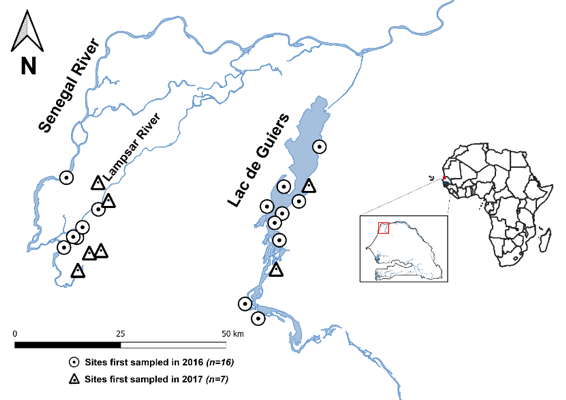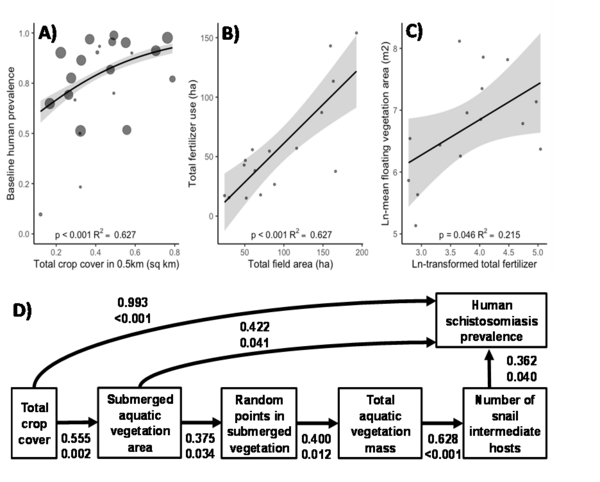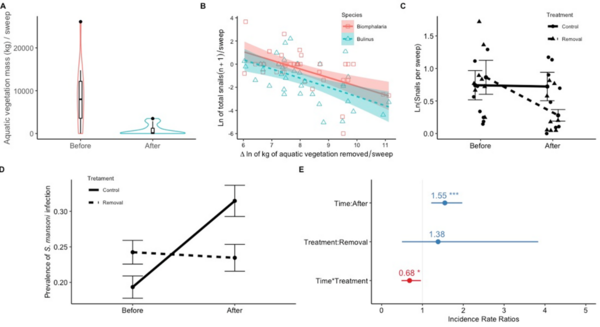Disease, Fertilizer Pollution, and Sustainability
To test for associations among agriculture and schistosomiasis, we conducted collaborative research with 23 communities in the St. Louis-Richard Toll region of Senegal (Fig. 1), quantifying the amount of (i)agricultural fields, fertilizer, and other agrochemical applications within a 0.5-km radius from the center of each village, (ii) submerged aquatic vegetation in water access points, (iii) snails that transmit human Schistosoma worms, and (iv) human Schistosoma infections in ~1,700 schoolchildren.
 Fig. 1. Map of 23 sampled sites located along the lower Senegal River (left site cluster) and Lac de Guiers regions (right site cluster) of northern Senegal. All site point locations are displayed on a single map enlarged from red polygon of the inset map on the right showing the country of Senegal within Africa. Circular symbols denote sites first sampled for baseline infection in 2016 and tested for infection post-treatment in both 2017 and 2018 (n=16), while triangles denote sites sampled only for baseline infection in 2017 (n=7). This figure was created using the Africa Basemap in ESRI 2011. ArcGIS Desktop: Release 10. Redlands, CA: Environmental Systems Research Institute. Waterbodies within Senegal were selected using the Land cover of Senegal—Globe cover Regional dataset available from the Food and Agriculture Organization of the United Nations (http://www.fao.org/geonetwork/srv/en/main.home?uuid=ba4526fd-cdbf-4028-a1bd-5a559c4bff38).
Fig. 1. Map of 23 sampled sites located along the lower Senegal River (left site cluster) and Lac de Guiers regions (right site cluster) of northern Senegal. All site point locations are displayed on a single map enlarged from red polygon of the inset map on the right showing the country of Senegal within Africa. Circular symbols denote sites first sampled for baseline infection in 2016 and tested for infection post-treatment in both 2017 and 2018 (n=16), while triangles denote sites sampled only for baseline infection in 2017 (n=7). This figure was created using the Africa Basemap in ESRI 2011. ArcGIS Desktop: Release 10. Redlands, CA: Environmental Systems Research Institute. Waterbodies within Senegal were selected using the Land cover of Senegal—Globe cover Regional dataset available from the Food and Agriculture Organization of the United Nations (http://www.fao.org/geonetwork/srv/en/main.home?uuid=ba4526fd-cdbf-4028-a1bd-5a559c4bff38).
The best fitting path model (Fig. 2, from Rohr et al. 2023.) provided support for the hypothesis that agriculture increases fertilizer use, which increases nutrient and snail habitat in waterbodies, and this in turn fuels snails, Schistosoma parasites, and schistosomiasis prevalence in schoolchildren (Fig. 1).
 Fig. 2. Observed associations between agriculture and human schistosomiasis in Senegal. Regardless of whether we controlled for human population size, agriculture was positively associated with (A) schistosomiasis prevalence in children (combined Schistosoma mansoni and S. haematobium infections; size of points is proportional to number of children tested) and (B) self-reported fertilizer use. (C) Although fertilizer use was positively associated with the amount of aquatic vegetation (Rs = 0.56, p = 0.034), this pathway was not included in the path model because fertilizer use was only available for a subset of sites (n=16). (D) Best fitting path model for the associations between agriculture and human schistosomiasis infection prevalence in schoolchildren (n=23 independent villages, combined S. mansoni and S. haematobium infections; see Methods in Rohr et al. 2023). Positive effects are shown as black arrows and standardized effect sizes, followed by probability values, are provided under each path (calculated from a piecewise structural equation model). Sampling effort (random points in submerged vegetation) increased proportionally to the surface area of submerged vegetation, and this surface area was associated positively with estimates of vegetation mass, which represents the primary three-dimensional habitat for snails. The final path model was a good fit to the data (Test of directed separation: C16 = 25.2, p = 0.067; SI Appendix Text S1). In panels A-C, gray bands are 95% confidence bands and statistical tests were two-sided and conducted with Generalized Linear Models.
Fig. 2. Observed associations between agriculture and human schistosomiasis in Senegal. Regardless of whether we controlled for human population size, agriculture was positively associated with (A) schistosomiasis prevalence in children (combined Schistosoma mansoni and S. haematobium infections; size of points is proportional to number of children tested) and (B) self-reported fertilizer use. (C) Although fertilizer use was positively associated with the amount of aquatic vegetation (Rs = 0.56, p = 0.034), this pathway was not included in the path model because fertilizer use was only available for a subset of sites (n=16). (D) Best fitting path model for the associations between agriculture and human schistosomiasis infection prevalence in schoolchildren (n=23 independent villages, combined S. mansoni and S. haematobium infections; see Methods in Rohr et al. 2023). Positive effects are shown as black arrows and standardized effect sizes, followed by probability values, are provided under each path (calculated from a piecewise structural equation model). Sampling effort (random points in submerged vegetation) increased proportionally to the surface area of submerged vegetation, and this surface area was associated positively with estimates of vegetation mass, which represents the primary three-dimensional habitat for snails. The final path model was a good fit to the data (Test of directed separation: C16 = 25.2, p = 0.067; SI Appendix Text S1). In panels A-C, gray bands are 95% confidence bands and statistical tests were two-sided and conducted with Generalized Linear Models.
Given the positive association between agriculture and the prevalence of Schistosoma infections that seems to be mediated by aquatic vegetation, we predicted that we could disrupt this relationship and increase open water access (see Water tab for water results) by removing vegetation from water access points (Fig. 3).
 Fig. 3. Hypothesis that removing aquatic vegetation should reduce human schistosomiasis by reducing habitat for snails, the intermediate host for the pathogen.
Fig. 3. Hypothesis that removing aquatic vegetation should reduce human schistosomiasis by reducing habitat for snails, the intermediate host for the pathogen. To test this hypothesis, we implemented a three-year cluster randomized controlled trial in 16 communities (i.e., clusters) in Senegal, quantifying effort to remove vegetation and abundance of snails, aquatic vegetation, open water, and Schistosoma infections in >1,400 schoolchildren before and after vegetation removal in half of the communities. All infected schoolchildren received praziquantel annually to treat Schistosoma infections regardless of whether Schistosoma eggs were detected in their feces or urine.
We removed an estimated 433 metric tons (wet weight) of submerged aquatic vegetation during the study (Fig. 4a). Vegetation removal was associated with an 8-fold reduction in snails in the following year (Fig. 4c). The more vegetation we removed, the more Biomphalaria and Bulinus snail abundance declined (Fig. 4b). Control sites had 1.46 times the S. mansoni infection rate of the removal sites (Fig. 4d), or in other words, the infection rate in schoolchildren in the vegetation removal sites was 68% of the infection rate observed in the control sites (Fig. 4e, from Rohr et al. 2023.).
 Fig. 4. The relationship between vegetation removal, snails, and rate of infection (A) Mean (midline) non-emergent vegetation mass (g) per sweep removed during the first and subsequent quarterly vegetation removal events at 16 water access points located in 8 independent villages (box is first and third quartile, whiskers represent a 95% CI, points are outliers). (B) Association (with 95% confidence bands) between aquatic vegetation removed (ln(kg)) at water access points and the change (Δ) in Bulinus spp. snails (ln(snails +1)) collected per sweep before and after the initial vegetation removal. (C) Mean (±SE) snails per sweep (ln(snails +1)) sampled at the same locations before (data points are the 8 independent villages per treatment) and after the initial removal event. (D) Marginal mean prevalence (± SE) of S. mansoni in schoolchildren before and after the implementation of the vegetation removal intervention (n=8 independent villages per treatment). (E) The exponentiated incidence rate ratio coefficients (and 95% CI) for the effects of time (before or after intervention), treatment (vegetation removal or not), and the time-by-treatment interaction on the community-school mean rate of infection with S. mansoni. The significant coefficient for the time-by-treatment interaction indicates that the S. mansoni infection rate in the vegetation removal sites was 68% of that observed in the control sites, or in other words, the controls sites had 1.46 times the infection rate as the removal sites.
Fig. 4. The relationship between vegetation removal, snails, and rate of infection (A) Mean (midline) non-emergent vegetation mass (g) per sweep removed during the first and subsequent quarterly vegetation removal events at 16 water access points located in 8 independent villages (box is first and third quartile, whiskers represent a 95% CI, points are outliers). (B) Association (with 95% confidence bands) between aquatic vegetation removed (ln(kg)) at water access points and the change (Δ) in Bulinus spp. snails (ln(snails +1)) collected per sweep before and after the initial vegetation removal. (C) Mean (±SE) snails per sweep (ln(snails +1)) sampled at the same locations before (data points are the 8 independent villages per treatment) and after the initial removal event. (D) Marginal mean prevalence (± SE) of S. mansoni in schoolchildren before and after the implementation of the vegetation removal intervention (n=8 independent villages per treatment). (E) The exponentiated incidence rate ratio coefficients (and 95% CI) for the effects of time (before or after intervention), treatment (vegetation removal or not), and the time-by-treatment interaction on the community-school mean rate of infection with S. mansoni. The significant coefficient for the time-by-treatment interaction indicates that the S. mansoni infection rate in the vegetation removal sites was 68% of that observed in the control sites, or in other words, the controls sites had 1.46 times the infection rate as the removal sites.For more information, see Rohr et al. 2023.